Eve Lazarus's Blog: Every Place has a Story, page 39
July 8, 2017
The East Cordova Street Murder Factory
When I was going through John Vance’s personal files for Blood, Sweat, and Fear, a small article torn from the pages of the long defunct Vancouver Star caught my eye. Vance’s handwriting dated it October 23, 1931 and it mentioned the murder of Naokichi Watanabe. Vance had clearly kept the clipping because he had testified that blood found on the suspect’s clothing was human.
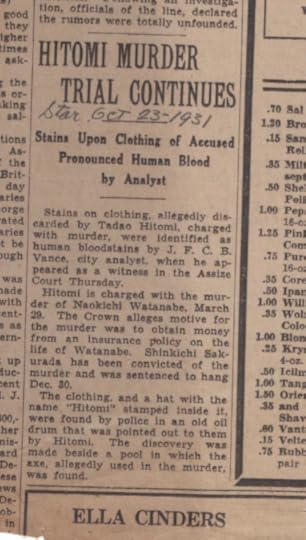
I looked up other stories around that date to find out more about the case and was intrigued to find that it was much bigger than one murder and revolved around a house that still exists on East Cordova Street, about a block or so over from the former Japantown.
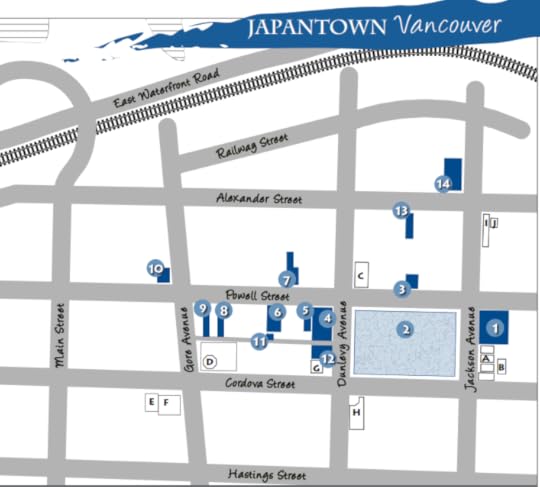 Historical Map-Guide, Japantown. Courtesy Vancouver Heritage Foundation.
Historical Map-Guide, Japantown. Courtesy Vancouver Heritage Foundation.In the heart of the Depression, Shinkichi Sakurada, a 40-year-old Hastings Sawmill worker, set himself up as a medicine man and started a private hospital in the six-room East Cordova house. Problem was, people would enter the hospital, take out an insurance policy, name him as their beneficiary, and shortly after, die.
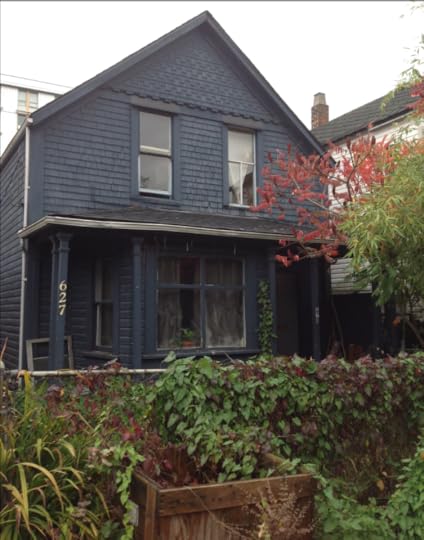 629 East Cordova Street. Eve Lazarus photo, 2017
629 East Cordova Street. Eve Lazarus photo, 2017The scheme began to derail when Watanabe’s body was found by Sakurada behind the American Can Company. Sakurada told police that Watanabe lived at his house and when he had gone out that night and not returned, he had became worried and went to search for him.
Watanabe, had injured his back on the job the previous year and was about to receive a cheque from the Workmen’s Compensation Board. He planned to return to Japan the following week. Knowing that if Watanabe left the country he would never recover the money from his insurance policy, Sakurada became desperate and hired Tadao Hitomi to kill him.
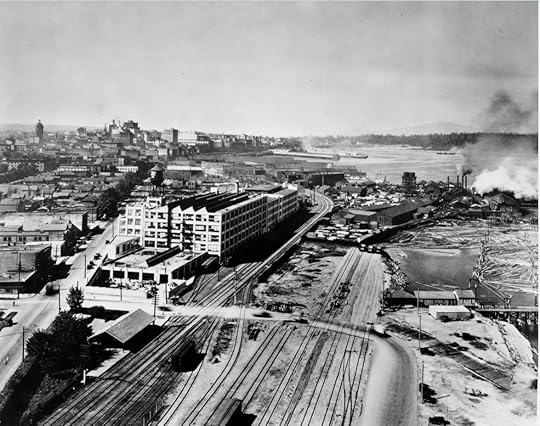 Naokichi Watanabe’s body was found lying across the CPR tracks behind the American Can Company at the foot of Princess Street. Hastings Sawmill is visible. Photo courtesy Vancouver Public Library, 1926
Naokichi Watanabe’s body was found lying across the CPR tracks behind the American Can Company at the foot of Princess Street. Hastings Sawmill is visible. Photo courtesy Vancouver Public Library, 1926The koroshi (killing) was reported widely in the Japanese papers, but the mainstream press took little interest until police called Sakurada’s modest house “a murder factory,” and the Globe and Mail ran a national story headlined “Murder Syndicate Collects Insurance on Victims’ Lives.” The newspaper reported that police suspected an “organized assassination ring” operated in Japantown and was responsible for as many as 20 deaths.
Sakurada and Hitomi were quickly dispatched to the gallows on December 30, 1931 at Oakalla Prison Farm.
You can read the full story in Blood, Sweat and Fear: The Story of Inspector Vance, Vancouver’s First Forensic Investigator, it’s one of the ten chapters in the book that follows individual crimes that Inspector Vance helped to solve during his 42-year career as head of the Police Bureau of Science (1907-1949).

June 30, 2017
What was there before? The Courthouse
The Vancouver Courthouse, bordered by Georgia, Hornby, Howe and Robson, was designed by celebrity architect Francis Rattenbury in 1907 and completed in 1911. Since 1983, it has been home to the Vancouver Art Gallery. Pamela Post wanted to know what sat on the site before. What she found was nothing and everything.
By Pamela Post
The answer surprised both me and the archivist at Vancouver Archives, as we peered at the old city map from the 1890s to early 1900s. Apparently, nothing.
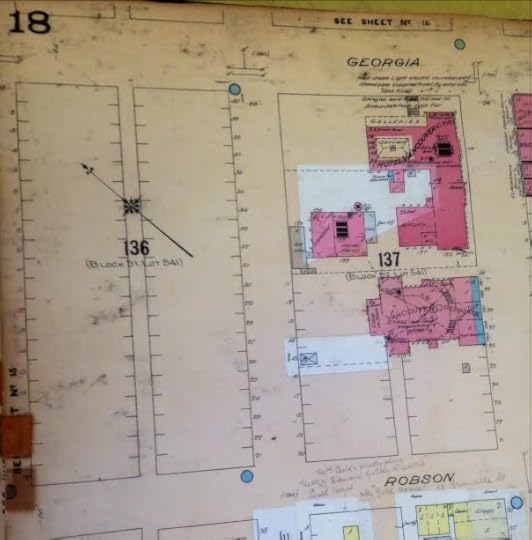 Prior to 1911 the square block bordered by Georgia, Hornby, Howe and Robson was a blank space on the map, save for the prosaic descriptor: Block 51, District Lot 541.
Prior to 1911 the square block bordered by Georgia, Hornby, Howe and Robson was a blank space on the map, save for the prosaic descriptor: Block 51, District Lot 541.Until men and their horses plowed the sod for the courthouse in 1909, it was nothing but a vacant lot, lumpy clear-cut CPR land that was bought by the province to build the courthouse that would replace the 1888 structure at Hastings and Cambie.
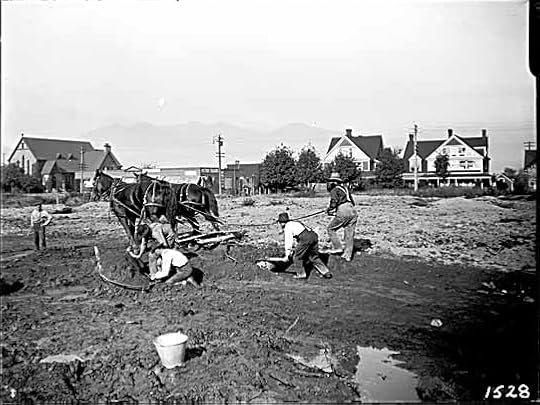 Clearing the land in 1909. Courtesy Vancouver Public Library
Clearing the land in 1909. Courtesy Vancouver Public LibraryUpon its completion in 1911 the Vancouver World gushed that the building “is one of the finest in the Empire!” While a local judge told a reporter that it equaled the new Strand Courts in London, England. The colonial fervor reached its height in 1912 at the official opening ceremony which was attended by the Duke of Connaught—Canada’s Governor General.
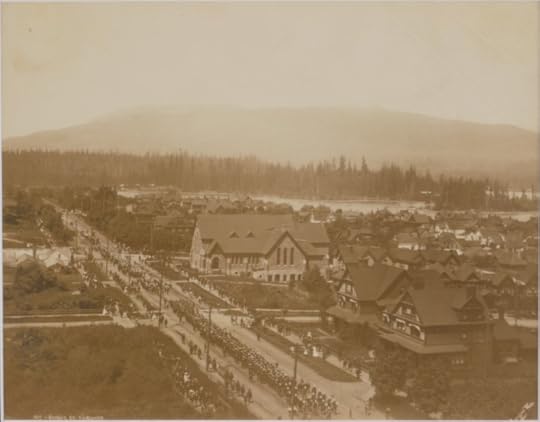 Christ Church Cathedral Georgia & Burrard, 1890s. Stephen Joseph Thompson photo.
Christ Church Cathedral Georgia & Burrard, 1890s. Stephen Joseph Thompson photo.Over a century later, on this controversial Canada Day 150, the question ‘What was there before?’ demands a much deeper answer viewed through the lens of over 10,000 years of indigenous history in a place where Coast Salish peoples lived and thrived for millennia.
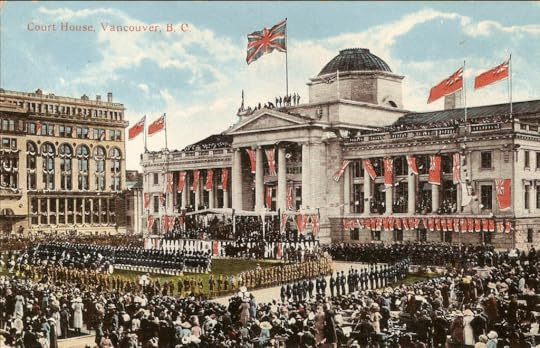 The opening of the Courthouse in 1912 with the Governor General in attendance
The opening of the Courthouse in 1912 with the Governor General in attendanceIn 1996, Gitsxan artist and elder Doreen Jensen spoke to that question in an essay she wrote for an exhibition of contemporary First Nations art that she co-curated for the Vancouver Art Gallery.
“Just 112 years ago, a powerful rainforest covered the place where the Vancouver Art Gallery now stands. Trees rose 312 feet into the coastal sky. Streams made their way through the woodland where bears, beavers, wolves, elk and other animals made their homes. First Nations people were part of this complex ecosystem. They harvested trees for lumber, cutting slabs from the standing trees in a way and a season so the trees could continue to thrive.”
For decades, she writes, indigenous peoples and their cultures were treated with contempt within the walls of the Vancouver courthouse and later the VAG.
LaxHösinsxw is an important word in the Gitxsan language, writes Jensen, explaining that it means honouring and respecting others, place and space.
“In this city, at this site and at this time in history, it is a word we might learn from. The place and space in which the Vancouver Art Gallery stands, physically and metaphorically, is a contested one. Here, where a city has been incompletely exchanged for the forest and newcomers have incompletely replaced the aboriginal inhabitants, LaxHösinsxw may be key to the creative process and to our future.”
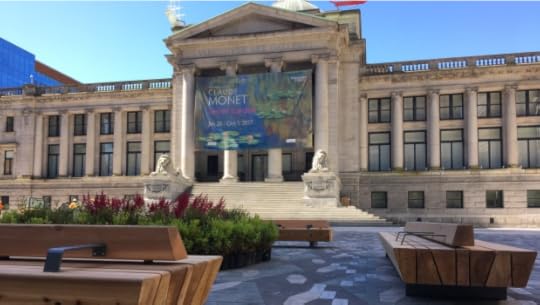 Currently, the new $9.6 million dollar plaza at the VAG showcases a very European Monet poster. I would have preferred to see the invocation Jensen wrote about that site:
Currently, the new $9.6 million dollar plaza at the VAG showcases a very European Monet poster. I would have preferred to see the invocation Jensen wrote about that site:
“The past creates an energy in the present, whether we know it or not. The ancient forest and its metamorphosis into timber, then real estate, is still part of this place.”
Pamela Post is an award-winning journalist, broadcaster and creative writer. She teaches journalism at Langara College. She was born and lives in Vancouver’s West End and is Tsimshian First Nations from Kitsumkalum on her father’s side.

June 24, 2017
The Chinese Labour Corps: One of BC’s Best Kept Secrets
Robert Ashton kindly sent me this photo of hundreds of Chinese men standing on a hill with rows and rows of white army bell tents in the background.
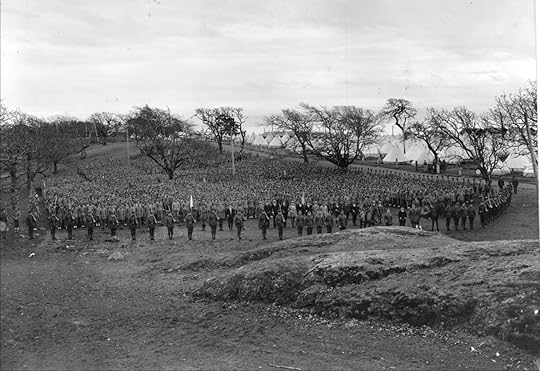 Photo courtesy Vancouver Archives Mil P194, 1918
Photo courtesy Vancouver Archives Mil P194, 1918He also found a 1920 copy of Pacific Marine Review with this story.
“During the last five months, almost 50,000 Chinese coolies have passed through the port of Vancouver on their way from work in the European war zone back to their homes in China. At times the congestion at the Williamshead quarantine station has been very great. For instance, at the end of the second week in March there were over 8000 coolies housed at that point. On March 14 the steamer Ixion sailed with 3625 of these Chinamen and during the same week the steamer M.S. Dollar took 4300 and the Bessie Dollar took those remaining or about 1400. As the steamship companies got $55 each for transporting the men across the Pacific, it can readily be seen that these vessels will net a nice little sum out of this work.”
Robert wanted to know if anyone knew where the photo was taken. And, so did I.
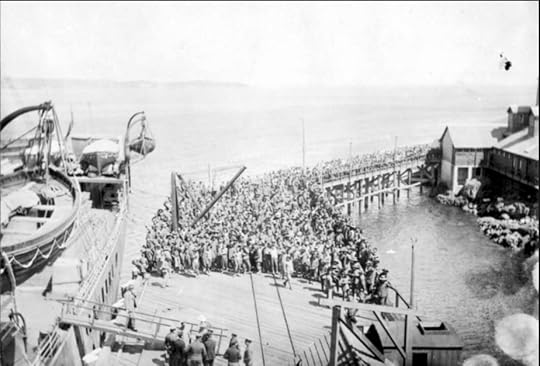 Members of the Chinese Labour Corps at William Head . BC Archives EO-6996, 1917
Members of the Chinese Labour Corps at William Head . BC Archives EO-6996, 1917William Head, it turns out, is in Metchosin, just outside of Victoria. It was a quarantine station from 1872 to 1959 designed to stop the spread of smallpox, leprosy and meningitis. The station was equipped to handle 800 people in a 42-building, 106-acre facility.
Between 1917 and 1920 more than 84,000 Chinese were held there in quarantine.
The men were part of the Chinese Labour Corps, a secret division formed under the British Army during the First World War. More than 90,000 “volunteer” workers from China and Mongolia were told that they were being recruited to work as labourers in non-combative roles.
The Chinese boarded ships in eastern China, crossed the pacific and were quarantined at William Head. After a brief stay they were put on guarded trains and taken to the east coast where they sailed to France.
According to author, Peter Johnson* when the Chinese landed at Dunkirk they were fired at, gassed and thrown into whatever war-time horrors were happening on any given day.
 Aerial photo of William Head Prison from Wikimapia
Aerial photo of William Head Prison from WikimapiaThe former quarantine station and some of the buildings were incorporated into the William Head Institution—a minimum-security prison that opened in 1959 and houses 180 inmates.
*Peter Johnson is the author of Quarantined: Life and Death at William Head Station: 1872-1959, Heritage House Publishing, 2013.
© All rights reserved. Unless otherwise indicated, all blog content copyright Eve Lazarus.

June 17, 2017
Italian Heritage Month – meet the East End’s Angelo Branca
One of the best parts about messing around with history, especially criminal history, is digging up connections. Angelo Branca appears as a Canadian middleweight boxing
 Angelo Branca in the 1930s
Angelo Branca in the 1930schampion in the 1930s, and as the scrappy East End (Strathcona) lawyer and defender of madams and bookies in At Home with History.
In Sensational Vancouver, he is defence attorney to notorious brothel owner Joe Celona during the Tupper Royal Commission into police corruption. In another chapter, he pops up as a patron of former VPD detective Joe Ricci’s West Coast Central Club, and in another, he is boss and close friend to Tosca Trasolini a pilot and member of the Flying Seven, Canada’s first all-female aviator club.
In Blood, Sweat, and Fear, Branca swaps sides in 1935 and defends 17 VPD officers suspended for corruption. Every one of them got their job back. Ten years later he is defending a soldier accused of murdering a young woman in English Bay in 1945. It’s one of the few cases he loses in his career.
 Angelo Branca boxing in the 1930s. Courtesy Ray Culos
Angelo Branca boxing in the 1930s. Courtesy Ray CulosDuring his career, Branca defended 63 people on murder charges, and only one, Domenico Nassa, received the death penalty in 1928. Branca told his biographer that he had no quibble with that decision, but he didn’t think the soldier deserved to hang, and he fought the verdict all the way to the British Columbia Court of Appeal. He often took on pro bono cases.
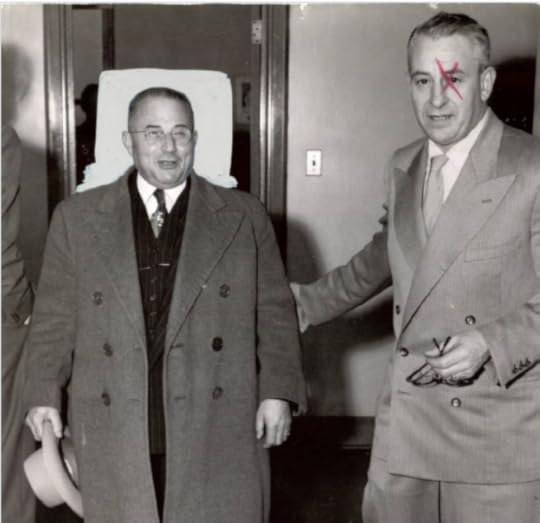 Angelo Branca with client Joe Celona. Province photo, 1955.
Angelo Branca with client Joe Celona. Province photo, 1955.Branca was born in 1903 and grew up at 343 Prior Street with parents Teresa and Filippo, two brothers John and Joseph and sister Anne. Filippo ran the grocery store on Main Street and he and Peter Tosi and Sam Minichiello were the three biggest importers of California grapes in the area.
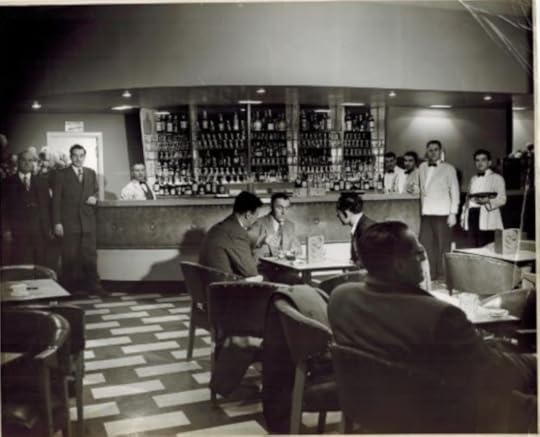 West Coast Central Club, Main Street, ca.1950. Joe Ricci far left. Photo courtesy Louise Ricci
West Coast Central Club, Main Street, ca.1950. Joe Ricci far left. Photo courtesy Louise RicciMy favourite story comes from Ray Culos whose grandfather was Sam Minichiello, and says that the joke in the neighbourhood was that wine was a family affair. Filippo would sell the grapes to the bootleggers, his son John, a detective with the dry-squad would arrest them, and his other son, Angelo, would get them off in court.
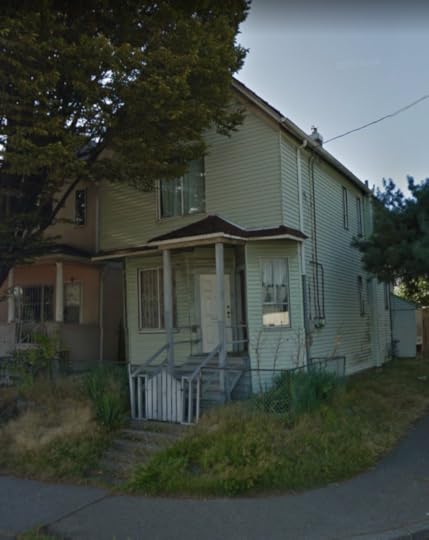 343 Prior Street, Vancouver 2017. Photo Google maps.
343 Prior Street, Vancouver 2017. Photo Google maps.The Canadian Lawyer magazine wrote that Branca was the most famous criminal defense lawyer in Canada’s history. In 1963, he became a Supreme Court judge. Branca died in 1984.
To read more about his remarkable life, check out:
Vincent Moore’s book: Gladiator of the Courts, Douglas and McIntyre, 1981
Ray Culos’s website
© All rights reserved. Unless otherwise indicated, all blog content copyright Eve Lazarus.

June 10, 2017
Inspector Vance and the Noir Magazines of the 1930s and ’40s
One of the many fascinating things that Inspector John Vance packed away when he retired from the Vancouver Police Department in 1949 were several true crime magazines. He appeared in all of them. Reporters were intrigued by this scientist who was able to convict criminals through the tiniest piece of trace evidence, or determine death by poison, or through his forensic skills in serology and firearms examination.
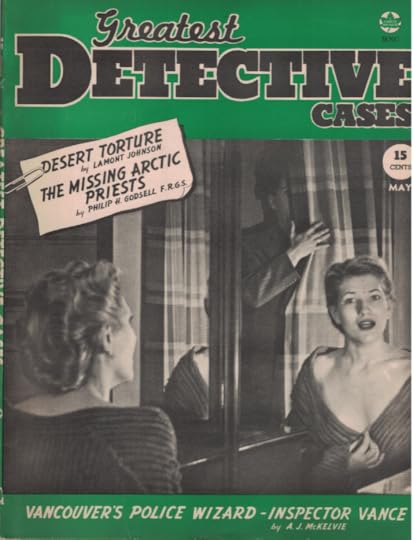
Reporters moonlighted for these magazines and had cozy relationships with police and sources that gave them access to information and photos unheard of on any crime beat today.
The early magazines ran fictionalized versions of sensational crimes. In one ironically called Real Crime Cases, Vance takes a starring role in a story called the “Mystery of the Missing Mrs. Millard” based on a 1914 murder investigation. The case is the first chapter in Blood, Sweat, and Fear, and it’s fascinating to read the “real” version in the magazine. In the magazine, Vance becomes a detective and is even given lines and solves the case. In reality, it was the first police case he worked on, and his job was to test a stain found on the carpet to see if it was blood.
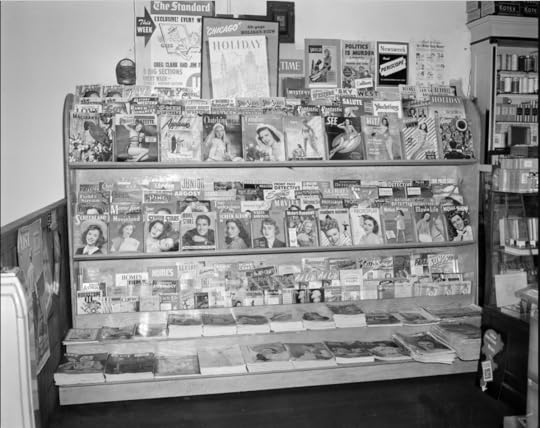 A typical drugstore display of magazines in the early 1940s. Courtesy CVA 1184-3279
A typical drugstore display of magazines in the early 1940s. Courtesy CVA 1184-3279In another case that I wrote about in Blood, Sweat, and Fear, the story of two murdered police officers in Merritt written up in Master Detective was so detailed and accurate with accompanying crime scene photos that it resulted in a sharp warning from the trial judge.
Later Vance appears in Inside Detective with the headline “They couldn’t kill the crime doctor.” He appears again in Special Detective Cases in a feature called “He makes his own miracles,” and in May 1942, Vance is the subject of a three-page feature in Greatest Detective Cases “Vancouver’s Police Wizard: Inspector Vance.”
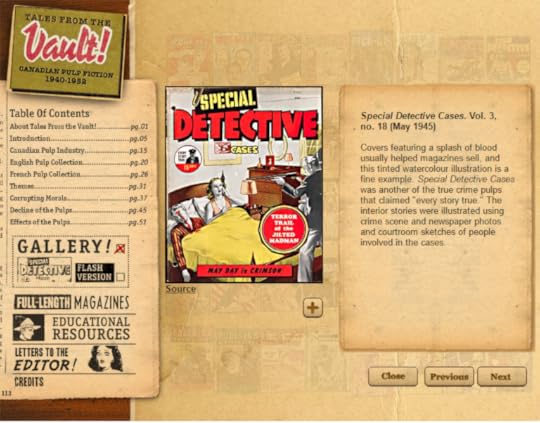
According to a recent Vancouver Sun story the Canadian market for detective magazines came to an end when “moral outrage led to a 1949 Canadian law banning pictorial depictions of the commission of crimes real or fictitious,” sucking all the fun from the articles.
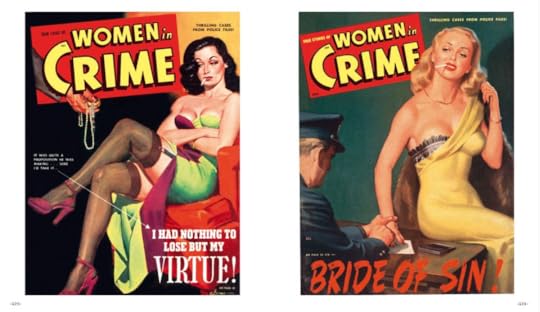
Predictably, Canadian true crime was a lot milder than its US counterparts. These were more like soft porn that featured cartoon-like pictures of women bound and gagged.
Detective magazines had a longer run in the U.S., they lasted into the 1970s, True Detective, which launched in 1924, managed to hang on until 1996. While interest in true crime never waned, tabloid television replaced the magazine.
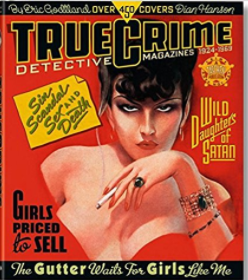
© All rights reserved. Unless otherwise indicated, all blog content copyright Eve Lazarus.

June 3, 2017
Chesterfield House
If you live in North Vancouver you may have noticed the old Tudor-style house at Chesterfield and Osborne in the upper Lonsdale Area.
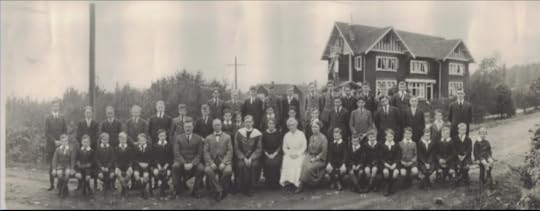
It’s hard to see these days, because several years ago we allowed developers to build two large “carriage” houses, in what was once a magnificent front garden filled with hollies, laburnums, cedars, black walnuts, a cherry tree, a rose garden, and a large rhododendron.
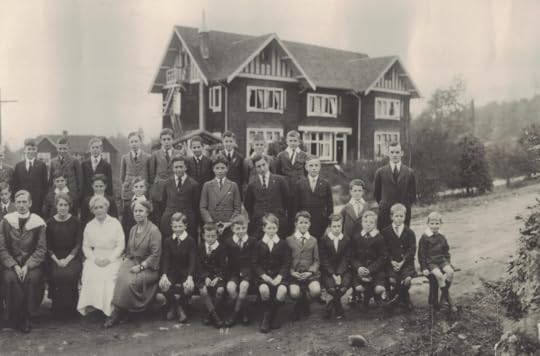 Chesterfield House School, ca.1920. Courtesy Eric L. Williams
Chesterfield House School, ca.1920. Courtesy Eric L. WilliamsI was reminded again of its story this week when Eric Williams kindly sent me this photo of his father’s school class.
Chesterfield House became a boy’s school in 1913 after it moved from its first location at the corner of 14th and Lonsdale. The grounds covered several lots and included two buildings—the main house with dorms, a dining room and offices, and the school house with classrooms and science labs. There was also a gymnasium, a swimming pool, and a stable for six horses.
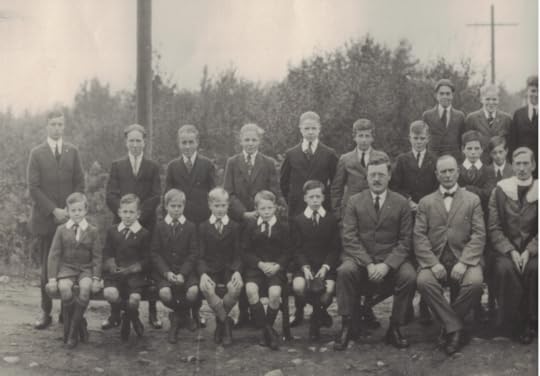 Chesterfield School ca.1920. Cyril Eddowes Halsey Williams is front row fourth from left. Courtesy Eric L. Williams
Chesterfield School ca.1920. Cyril Eddowes Halsey Williams is front row fourth from left. Courtesy Eric L. WilliamsAs Eric points out, you can see the British influence in everything from the style of the
 Chesterfield House, courtesy NVMA 4528
Chesterfield House, courtesy NVMA 4528building to the clothes worn by teachers and the boy’s uniforms.
“My father doesn’t seem to be particularly happy at that moment, but subsequently delighted in relating anecdotes concerning the pranks the boys played on each other,” says Eric.
Eric’s father, (Canon) Cyril Eddowes Halsey Williams went on to study at the Anglican Theological College (now Vancouver School of Theology) at UBC. After graduating he was posted to the Yukon and later to the interior. He wrote a book called Archdeacon on Horseback, a year before his death in 1992.
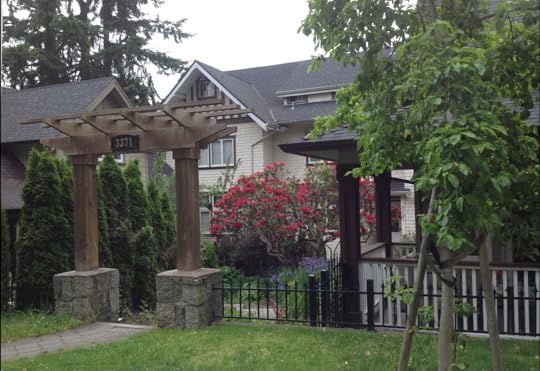 Chesterfield house now a rental apartment building peaking out between two “carriage houses.” Eve Lazarus photo
Chesterfield house now a rental apartment building peaking out between two “carriage houses.” Eve Lazarus photoAccording to Sharon Proctor’s story in Express, Chesterfield operated in the British tradition with male teachers and ties to the Anglican Church. “Its goal was to prepare boys for entrance to Universities, Royal Naval and Military Colleges, and business.” The Chesterfield Boy Scout program consisted of 20 boys who were frequently dispatched to fight local forest fires.
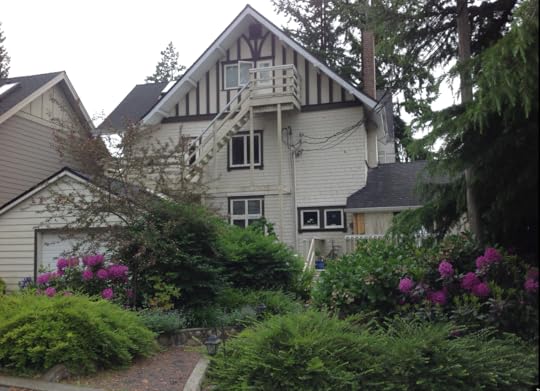 Chesterfield House from Osborne Road West. You can reach out and touch the wall of the “Carriage” house. Eve Lazarus photo.
Chesterfield House from Osborne Road West. You can reach out and touch the wall of the “Carriage” house. Eve Lazarus photo.The school closed in 1942 and was converted into an apartment building. It’s the only part of the school that still exists.
Thanks to Tom Carter for “stitching” the very large photo into one piece.
© All rights reserved. Unless otherwise indicated, all blog content copyright Eve Lazarus.

May 27, 2017
Our Missing Heritage–The Georgia Medical-Dental Building: what were we thinking?
On May 28, 1989, we blew up the Georgia Medical-Dental Centre, a building on West Georgia designed by McCarter & Nairne, the same architects behind the Marine and the Devonshire Apartments. *
 And there goes the Georgia Medical-Dental Building in 1989
And there goes the Georgia Medical-Dental Building in 1989The Devonshire was first, designed as an apartment building in 1923. Next came the 15-storey art deco medical building—and the Marine Building was completed in 1930—the only one left standing.
 Leonard Frank photo in 1929 showing the Georgia Medical-Dental Building under construction, next to the Devonshire and the Georgia Hotel.
Leonard Frank photo in 1929 showing the Georgia Medical-Dental Building under construction, next to the Devonshire and the Georgia Hotel.As this more recent photo shows, the HSBC Building now sits where the elegant Devonshire Hotel used to be, and the medical building was blown up or perhaps blown down is more accurate—to make way for the twenty-three-storey Cathedral Place.
 Cathedral Place replaced the Georgia Medical Dental Building
Cathedral Place replaced the Georgia Medical Dental BuildingI quite like Cathedral Place. It’s nicely tiered, the roof fits in with the Hotel Vancouver across the street, and it even has a few nurses, gargoyles and lions pasted about as a reminder of the former building. Everyone over 35 likely remembers the three nurses in their starchy World War 1 uniforms looking down from their 11th storey parapets. The Rhea Sisters, as they were known, were made from terra-cotta and weighed several tonnes each. The nurses were restored and are now part of the Technology Enterprise Facility building at UBC
But here’s a thought. Instead of honouring a heritage building by sticking fibreglass casts on a new building, why not just keep the original one!
 Fibre glass nurse at Cathedral Place
Fibre glass nurse at Cathedral PlacePaul Merrick, the architect who designed Cathedral Place, and who did such a nice job renovating the Marine Building, the Orpheum Theatre, and converting the old BC Hydro Building to the Electra, could have easily designed Cathedral Place someplace else. The Georgia Medical-Dental Building was only sixty after all—hardly old enough for its unseemly demise, but old enough to represent a significant part of our history.
I never saw the Devonshire, it came down in 1981, but I love one of its stories. According to newspaper reports after being kicked out of the snotty Hotel Vancouver in 1951, Louis Armstrong and his All Stars walked across the street and were immediately given rooms in the Devonshire. Walter Fred Evans, a one-time member of the Vancouver Symphony Orchestra built the Devonshire, and supposedly Duke Ellington, Lena Horne and the Mills Brothers wouldn’t stay anywhere else.
 The Devonshire Hotel, West Georgia, CVA LGN 1060 ca.1925
The Devonshire Hotel, West Georgia, CVA LGN 1060 ca.1925* McCarter & Nairne also designed the Patricia Hotel, 403 East Hastings; Spencer’s Department Store (now SFU at Harbour Centre); the Livestock Building at the PNE, and the General Post Office on West Georgia.
For more posts see: Our Missing Heritage
© All rights reserved. Unless otherwise indicated, all blog content copyright Eve Lazarus.

May 20, 2017
Tom Butler, The Coach House Inn, and the Belly Flop that Soared
It’s hard to fathom how anyone could think that a belly flop competition was a good idea, but Tom Butler did back in the ‘70s, and as it happens, it was.
 Who needs a diving board when you have a hot air balloon. The World Belly Flop and Cannonball Diving Championship at the Coach House Inn in North Vancouver. Photo courtesy John Denniston, 1979
Who needs a diving board when you have a hot air balloon. The World Belly Flop and Cannonball Diving Championship at the Coach House Inn in North Vancouver. Photo courtesy John Denniston, 1979Former Sun reporter, turned PR guy, Butler was the master of the photo op. Having Margaret Trudeau turn up to the opening night of a small North Vancouver disco scored national attention for his client. He talked Neil Armstrong, the astronaut to come to Vancouver and open a revolving restaurant above the Sears Tower (now the Vancouver Lookout) and slapped on the slogan: “The restaurant that soars halfway to the moon in the night sky over Vancouver was opened by a man who went all the way.”
He borrowed a beaver from the Stanley Park zoo for a cross US tour to promote local tourism. According to a Globe and Mail story of 1979: “The beaver scrambled up the steps of San Francisco City Hall to be hugged by the mayor, and promptly committed an indignity of relieving itself.” The front-page caption in the next day’s paper was “Damn That Beaver.”
But back to belly flops.
 The Coach House Inn at 700 Old Lillooet Road, by the Second Narrow Bridge. Photo courtesy NVMA 16055
The Coach House Inn at 700 Old Lillooet Road, by the Second Narrow Bridge. Photo courtesy NVMA 16055Butler invented the World Belly Flop and Cannonball Diving Championship in 1974 to publicize the Bayshore Hotel’s new pool, and it quickly gained momentum and spread to the old Coach House Inn in North Vancouver. According to photographer John Denniston, the “event” drew in between three and four thousand spectators, entrants from Fiji and Japan, as well as US President Jimmy Carter’s brother Billy as a judge, and coverage from NBC television.
In 1976, the American Hotel and Motel Association recognized the belly-flop as North America’s best publicity stunt for that year.
“It’s something that is universally understood,” Butler told the G&M. “I mean, there’s no subtlety to it. But what else can a 300-pound truck driver do and get to have NBC declare that he’s champion of the U.S.A.?”
Miss 1979 Belly Flop was won by Christie Wilson, a 26-year-old stripper who went by the stage name “Big Fanny Annie.”
 Coach House lobby in the 1970s. The doors by the fireplace led to the pool. Upstairs were the rooms and dinner lounge. With thanks to Sharon Proctor and the NVMA 16066
Coach House lobby in the 1970s. The doors by the fireplace led to the pool. Upstairs were the rooms and dinner lounge. With thanks to Sharon Proctor and the NVMA 16066Butler eventually retired to Prince Edward Island, and died in 2013. He was 79.
In his obituary, Ian Haysom mentions that he wrote an autobiography called PR Man. I haven’t been able to get hold of a copy, but it would be worth it just for this story.
“He brought Zsa Zsa Gabor to Vancouver for the opening of the Royal Centre shopping complex,” writes Haysom. “She was, he said, the most obnoxious personality he had ever met. ‘Imagine, if you will, spending four days minding someone else’s cranky brat going through the terrible twos’.”
The book apparently has a huge belly-flop contestant leaping off a springboard and the tagline: “A little song, a little dance, a little seltzer down your pants.” Let me know if you have a copy I can borrow.
© All rights reserved. Unless otherwise indicated, all blog content copyright Eve Lazarus.

May 13, 2017
Margaret Trudeau and the Daddy Long Legs Disco
Last Christmas, my friend Jason Vanderhill gave me a card showing a couple of disco dancers from the ‘70s. The caption explained that the photo was taken at the opening of something called Daddy Long Legs in North Vancouver.
 Disco dancers at the opening of Daddy Long Legs at the International Plaza Hotel in North Vancouver. July 31, 1979. Bill Keay/Vancouver Sun
Disco dancers at the opening of Daddy Long Legs at the International Plaza Hotel in North Vancouver. July 31, 1979. Bill Keay/Vancouver SunThe only thing I could find out about the Daddy Long Legs disco was from a Globe and Mail article dated August 4, 1979 which focused on PR superstar Tom Butler rather than the venue he was promoting. “It was a public relations man’s dream,” went the lead. “Margaret Trudeau, the biggest newsmaker to storm the east from the North Shore’s sheltered heights, was boogying at the opening splash at Daddy Long Legs, a new North Vancouver Disco.”
 “Margaret’s boogying makes Tom Smile,” Globe and Mail, August 4, 1979
“Margaret’s boogying makes Tom Smile,” Globe and Mail, August 4, 1979The same picture appears in Kate Bird’s wonderful book Vancouver in the Seventies, and after a visit to the NVMA yesterday, we figured out that the hotel was built around 1975 and was at the corner of Marine Drive and Capilano Road. The 1980 city directory describes it as “Vancouver’s finest resort hotel.” The high-rise had 150 rooms all with colour television, complete convention facilities, restaurant dining, show lounge, garden bar, dancing, a heated indoor swimming pool, saunas, whirlpools, and tennis courts. John Hale was the general manager.
 The International Plaza, no longer Vancouver’s finest resort hotel in 2017.
The International Plaza, no longer Vancouver’s finest resort hotel in 2017.It doesn’t look like the disco or the hotel lasted very long because it quickly turned into the International Plaza Hotel and Apartment Complex in the city directories. The hotel’s facilities have since been repurposed into various fitness clubs (currently Steve Nash). Those who were there say the disco was on the top floor, and perhaps the “garden bar” was where the Staples is now.
Kate tells me they have photos of our Prime Minister’s mother dancing at the disco on opening night, but chose to include the above photo because there were other pictures of her in the book.
I’ll be writing more about Tom Butler in an upcoming blog.
© All rights reserved. Unless otherwise indicated, all blog content copyright Eve Lazarus.

May 6, 2017
They Paved Paradise and put up a Parking Lot: Larwill Park
 Bus Depot , 150 Dunsmuir Street in 1953. Photo Courtesy Vancouver Archives LP 205.4
Bus Depot , 150 Dunsmuir Street in 1953. Photo Courtesy Vancouver Archives LP 205.4My friend Angus McIntyre was a Vancouver bus driver for 40 years and often took photos of heritage buildings, neon signs, street lamps and everyday life on his various routes. His photos are always so vivid and interesting (see his posts on Birks and elevator operators) and when he sends me one, I stop whatever I’m doing and nag him for the back story.
 Inside the bus depot in 1979. Angus McIntyre photo.
Inside the bus depot in 1979. Angus McIntyre photo.Angus shot this photo of the old bus depot on Dunsmuir Street (Larwill Park) in 1979. He tells me: “This was just after Pacific Stage Lines had been dissolved, and Pacific Coach Lines had started the replacement service. The signs have tape covering the word ‘Stage’.” Angus says that on an earlier busy Sunday, employees conducted a mock funeral for Pacific Stage Lines. “Afterwards, there was a wake at the bus drivers’ booze can across the street on Dunsmuir. Seems Vancouver has this thing for mock funerals,” he says.
 Larwill Park today via Google Maps
Larwill Park today via Google MapsSeems we also have a thing for parking lots. Vancouver seems to revere parking lots as much as other cities value heritage buildings, public space, and art. (See Our Missing Second Hotel Vancouver).
Larwill Park is now the huge downtown parking lot that is bounded by Cambie, Dunsmuir, Beatty and Georgia Streets. It began life as the Cambie Street Grounds, a park and sports fields. And, being opposite the Beatty Street Drill Halls, at times operated as a military drill ground. The park was named after Al Larwill, who the story goes, was made “caretaker” after squatting in a shack on the land for many years. He was given a house on a corner of the land where he stored sports equipment and allowed team members to use his dining room to change.
 Military exercises Cambie Street Grounds ca.1907. Photo Vancouver Archives 677-980
Military exercises Cambie Street Grounds ca.1907. Photo Vancouver Archives 677-980In 1946, Charles Bentall of the Dominion Construction Company built the bus depot, and it opened the following year as the most modern in Canada. Pacific Stage Lines, Greyhound, Squamish Coach Lines and others operated out of the terminal, until car culture struck in the 1950s and ‘60s and some of the companies went under.
In 1979, when Angus took his photo, Pacific Stage Lines had just merged with Vancouver Island Coach lines to become Pacific Coach Lines. In 1993, the bus depot moved to Pacific Central Station and the land became a parking lot.
 How the Vancouver Art Gallery sees the future of Larwill Park.
How the Vancouver Art Gallery sees the future of Larwill Park.The Vancouver Art Gallery has its sights on the land and wants to turn it into a backdrop for its for its bizarre bento-box building.
For more posts see: Our Missing Heritage
© All rights reserved. Unless otherwise indicated, all blog content copyright Eve Lazarus.




